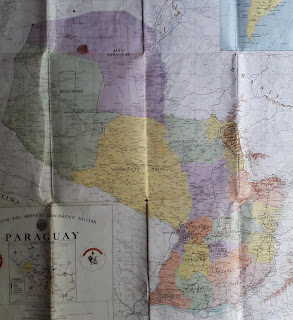Paraguay sits landlocked in the middle of South America. It is bordered on the east by Southern Brazil, on the north by Bolivia and on the south and west by Northern Argentina.
Landlocked as it is there is no coast or direct access to the sea but its connection to the Paraná river system means the even large ocean going vessels can reach Asunción which sits 1000km from the sea and is considered a deep water port.
The frontiers on the whole follow natural features with the rivers Paraná and Paraguay hemming it in from the east and west before joining together at the south east corner of the country where after joining they flow onto Argentina and the River Plate. Only in the north was any human creativity required to draw a border. There it runs across the sparsly populated and once disputed Chaco Desert.
The effect of these large rivers and the thorn bush scrub of the Chaco has been to develop in Paraguay a sense of isolation and seperation from all that surrounds it.
The land is on the whole flat lowlands that extend for miles in every direction and which are broken only by the occasional hill. This flat land gives rise to many swamps and slow moving rivers and is on the whole despite the distance from the sea is not far above sea level.
There are a few ranges of hills, across the center of the country and on the Brazilian border but these are on the whole not high. Where I live in Piribebuy is in the county or department named Cordillera for the high land within it. Although this is far from mountainous not rising to much more than 300 metres above sea level.
The land when looked at on a map appears as a lopsided figure of eight with the western section covering the Chaco and thinly populated and the east the wetter more habitable portion of the land.
Unsurprisingly most of the population lives in the east which is also divided into 14 of the 17 departments that make up Paraguay.
Later I will try and describe each of those departments but for now will end this general overview of the physical features of the land.


Recent Comments